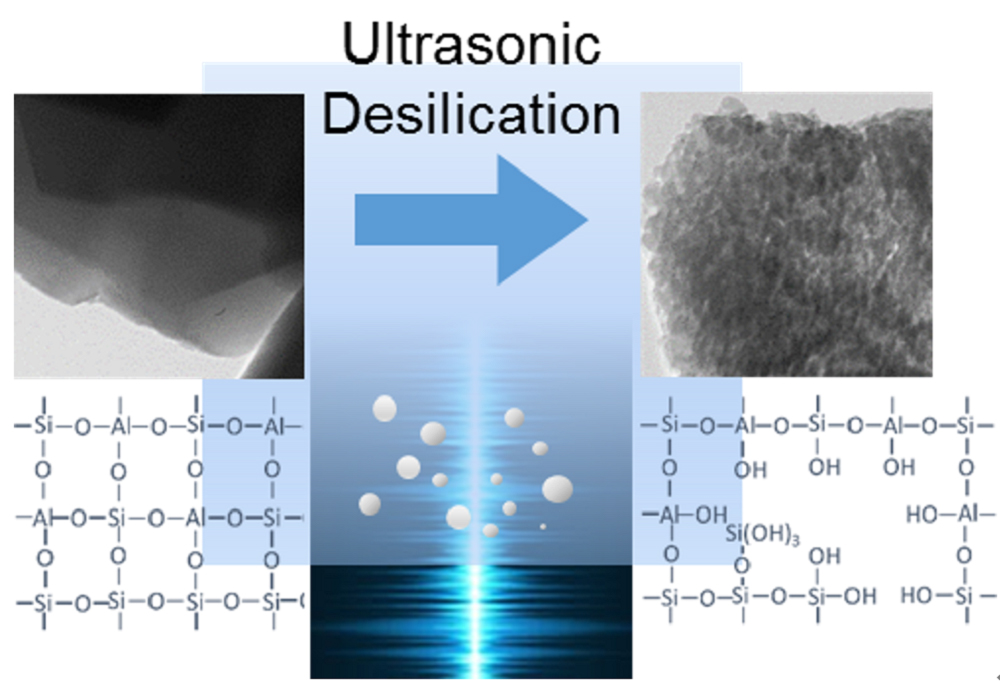Introduction
Materials and methods
Sequential post-synthesis treatments under hydrothermal conditions
Sequential post-synthesis treatments involving the ultrasound-assisted alkaline treatment
Characterisation of materials
Catalysis
Results and discussion
Tab.1 Si/Al ratios and RC values of the parent Y and EAY zeolites |
| Samples | Si/Al by XRF | RC by XRD |
|---|---|---|
| Parent Y | 2.60 | 100% |
| EAY-0.1-30min-HT | 3.88 | 89% |
| EAY-0.1-1h-HT | 3.88 | 87% |
| EAY-0.1-3h-HT | 4.05 | 85% |
| EAY-0.1-6h-HT | 4.39 | 71% |
| EAY-0.1-30min-S | 3.98 | 84% |
| EAY-0.1-1h-S | 3.86 | 83% |
| EAY-0.1-3h-S | 3.86 | 81% |
| EAY-0.1-6h-S | 4.25 | 64% |
Tab.2 Porous properties of the parent Y zeolite and EAY zeolites |
| Samples | Specific surface areas /(m2·g−1) | Specific pore volumes /(cm3·g−1) | ||||
|---|---|---|---|---|---|---|
| Smicroa) | Sexternala) | BET | Vmicroa) | Vmesob) | Vtotalc) | |
| Parent Y | 858 | 9 | 867 | 0.35 | 0.01 | 0.36 |
| EAY-0.1-30min-S | 722 | 82 | 804 | 0.33 | 0.12 | 0.45 |
| EAY-0.1-30min-HT | 757 | 61 | 818 | 0.34 | 0.09 | 0.43 |
| EAY-0.1-1h-S | 713 | 60 | 773 | 0.33 | 0.10 | 0.41 |
| EAY-0.1-1h-HT | 759 | 59 | 818 | 0.34 | 0.09 | 0.43 |
| EAY-0.1-3h-S | 706 | 63 | 769 | 0.32 | 0.10 | 0.42 |
| EAY-0.1-3h-HT | 711 | 59 | 770 | 0.32 | 0.09 | 0.41 |
| EAY-0.1-6h-S | 568 | 128 | 696 | 0.25 | 0.19 | 0.45 |
| EAY-0.1-6h-HT | 521 | 160 | 681 | 0.23 | 0.22 | 0.46 |
a) by the t-plot method; b) pore size range= 2–50 nm, calculations were based on the cumulative pore volume using the BJH method; c) single point adsorption total pore volume at p/p0 = 0.99. |
Tab.3 Si/Al ratios and values of relative crystallinity (RC) of the parent Y and CAY zeolites |
| Samples | Si/Al by XRF | RC by XRD |
|---|---|---|
| Parent Y | 2.60 | 100% |
| CAY-0.1-1h-HT | 3.95 | 86% |
| CAY-0.1-3h-HT | 4.02 | 82% |
| CAY-0.1-1h-S | 3.94 | 83% |
| CAY-0.1-3h-S | 3.95 | 81% |
| CAY-0.14-1h-S | 4.40 | 73% |
| CAY-0.16-1h-S | 4.92 | 69% |
Tab.4 Porous properties of the parent Y zeolite and CAY zeolites |
| Samples | Specific surface areas /(m2·g−1) | Specific pore volumes /(cm3·g−1) | ||||
|---|---|---|---|---|---|---|
| Smicroa) | Sexternala) | BET | Vmicroa) | Vmesob) | Vtotalc) | |
| Parent Y | 858 | 9 | 867 | 0.35 | 0.01 | 0.36 |
| CAY-0.1-1h-S | 545 | 82 | 627 | 0.28 | 0.14 | 0.42 |
| CAY-0.1-1h-HT | 491 | 76 | 567 | 0.26 | 0.10 | 0.36 |
| CAY-0.1-3h-S | 581 | 87 | 668 | 0.30 | 0.12 | 0.42 |
| CAY-0.1-3h-HT | 499 | 68 | 567 | 0.26 | 0.12 | 0.38 |
| CAY-0.14-1h-S | 531 | 206 | 737 | 0.23 | 0.25 | 0.48 |
| CAY-0.16-1h-S | 236 | 101 | 337 | 0.12 | 0.16 | 0.28 |
a) t-plot method; b) pore size range= 2–50 nm, calculations were based on Vtotal– Vmicro |
Tab.5 Analysis of NH3-TPD data for the parent Y and selected mesoporous Y zeolites |
| Catalysts | T of desorption peaks /°C | Weak acidity /(mmol·g−1) | Strong acidity /(mmol·g−1) | Total acidity /(mmol·g−1) | |
|---|---|---|---|---|---|
| First peak | Second peak | ||||
| HY-2.6 | 202.1 | 296.5 | 0.396 | 0.818 | 1.214 |
| EAY-0.1-6h-HT | 227.0 | 331.5 | 0.895 | 0.458 | 1.353 |
| EAY-0.1-6h-S | 225.0 | 315.9 | 0.743 | 0.544 | 1.287 |
| CAY-0.1-3h-HT | 227.5 | 325.5 | 0.815 | 0.618 | 1.433 |
| CAY-0.1-3h-S | 227.5 | 328.6 | 0.840 | 0.606 | 1.446 |











